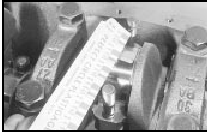Crankshaft and bearings - examination and renovation
1 Examine the bearing surfaces of the crankshaft for scratches or scoring and, using a micrometer, check each journal and crankpin for ovality. Where this is found to be in excess of 0.0254 mm (0.001 in) the crankshaft will have to be reground and undersize bearings fitted.
2 Crankshaft regrinding should be carried out by a suitable engineering works, who will normally supply the matching undersize main and big-end shell bearings.
3 Note that undersize bearings may already have been fitted, either in production or by previous repairer. Check the markings on the backs of the old bearing shells, and if in doubt take them along when buying new ones.
Production undersizes are also indicated by
paint marks as follows:
White line on main bearing cap - parent bore
0.40 mm oversize
Green line on crankshaft front counterweight
- main bearing journals 0.25 mm
undersize
Green spot on counterweight - big-end
bearing journals 0.25 mm undersize
4 If the crankshaft endfloat is more than the
maximum specified amount, new
thrustwashers should be fitted to the centre
main bearings. These are usually supplied
together with the main and big-end bearings
on a reground crankshaft.
5 An accurate method of determining bearing wear is by the use of Plastigage. The crankshaft is located in the main bearings (and big-end bearings if necessary) and the Plastigage filament located across the journal which must be dry. The cap is then fitted and the bolts/nuts tightened to the specified torque. On removal of the cap the width of the filaments is checked against a scale which shows the bearing running clearance. This clearance is then compared with that given in the Specifications (see illustration).

35.5 Checking the width of the filament against the scale of the packet
6 If the spigot bearing in the rear of the crankshaft requires renewal, extract it with a suitable puller. Alternatively fill it with heavy grease and use a close fitting metal dowel driven into the centre of the bearing. Drive the new bearing into the crankshaft with a soft metal drift.
See also:
Seating
Notes:
Reclining the seatback can cause an occupant to slide under the
seat's safety belt, resulting in severe personal injuries in the
event of a collision.
Do not pile cargo higher than the seat ...
Engine - refitting (automatic transmission in vehicle)
1 Reverse the procedure described in
Section 9, noting the following points.
2 Check that the engine adapter plate is
correctly positioned on its locating dowels.
3 As the torque converter is only ...
